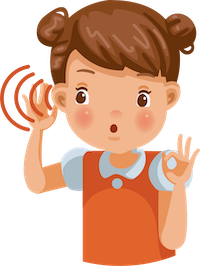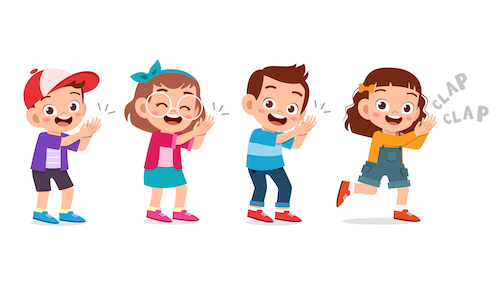Y2. Lesson 16. Marching and skipping
Prior learning: None
Duration: 30 minutes
Materials:
Keywords: Beat, rhythm, singing, chanting, partners, rhymes, circle games.
Difficulty: ![]()
Prepare
Present
Marching & skipping
Practise
Question & answer phrases
 Melodic development
Melodic development
![]() Students expand their knowledge of a mi-so-la song.
Students expand their knowledge of a mi-so-la song.
- Students are seated and attentive.
- Hum the first two measures and ask the class the song's name.
- Receiving a correct answer, ask the class to sing the song.
- When secure, ask the class to sing using time names.
- Next, ask students to sing using solfa.
- To assist, explain that the first note is so.
- When secure, ask how many different notes are in the song. [3]
- Ask the solfa names used in the song.
- Ask whether it would be better to march or to skip to the song.
 Questions
Questions
- Where was Sally sitting?
- In which two directions did she have to look?
 Rhythmic development
Rhythmic development
![]() Students listen and respond to music that makes them want to skip or march.
Students listen and respond to music that makes them want to skip or march.
- Listen to Examples: Play the songs on the player that fall into the skip and march categories, allowing the students to identify the characteristics of each style. Discuss what makes each song suitable for skipping or marching.
- Listen and Feel: Start by playing two different songs, one that has an upbeat, lively tempo (skip music) and another with a steady, marching tempo (march music). Ask the students to listen carefully and feel how the music makes them want to move.
- Demonstrate Skipping and Marching: After playing each song, demonstrate the actions. For skip music, you can skip or hop around playfully; for march music, march in place or walk with a steady rhythm. Encourage the students to join in and do the actions with you.
- Discuss Tempo: Explain that the tempo of a song is important. If the tempo is too slow, it is hard to skip. If it is too fast, then it is hard to march!
- Explore Rhythm: Introduce the concept of rhythm by clapping or tapping along to the music. For skip music, show them how to clap or tap quickly; for march music, demonstrate slow, steady claps or taps.
- Lyrics and Mood: If the songs you've chosen have lyrics, discuss how the words and the overall mood of the music match the actions. For example, skip music might have happy, playful lyrics, while march music might have lyrics about being strong and steady.
- Play Musical Games: Play games like musical chairs or freeze dance with different types of music. Use skip music for the lively games and march music for the games that require a steady pace. This hands-on approach helps reinforce the concepts.
- Create Your Own Music: Encourage creativity by having students make their own "skip" and "march" music using simple instruments like drums, shakers, or even their own voices. They can experiment with different rhythms and tempos.
- Visual Aids: Use visual aids like drawings or images of people skipping and marching to represent the music styles. This can help students associate the actions with the music.
- Compare and Contrast: Have discussions about why certain music makes them feel like skipping while other music makes them feel like marching. Encourage them to express their thoughts and feelings about the music.
 Creative movement
Creative movement
![]() Students sing and put the beat on their laps in this seated circle game.
Students sing and put the beat on their laps in this seated circle game.
- Students are seated in a large circle.
- A student is chosen to patrol the outside of the circle with a prop (such as a cap).
- Lead the class in singing the song as students put the beat on their laps.
- The chosen student skips to the beat.
- On the words 'one for me', they touch the cap to the nearest student's head.
- On the words 'one for you', they touch the cap to the next student's head.
- On the words 'one for sister/brother [student name], the student places the cap on the head of the last student.
- That student now patrols the perimeter, and the game begins again.
 Listening
Listening
![]() Students respond to rhythmic questions from the teacher.
Students respond to rhythmic questions from the teacher.

- Students are seated and attentive.
- Clap a four-beat rhythmic question, and students should reply with a different four-beat pattern.
- When secure, repeat with another four-beat pattern.
- Ask a student to clap a four-beat pattern, with the class responding back with another four-beat pattern.
- Sing one phrase from a song, and the students should respond with rhythmic syllables, echoing the phrase.
 Visual learning
Visual learning
![]() Students clap the rhythms shown on the board.
Students clap the rhythms shown on the board.
- Project the rhythm graphic.
- Explain to students that they will read the first line on the board and clap the rhythm as indicated.
- Ask students to say the time names as they clap.
- Lead the class in clapping and saying the time names.
- Monitor students to ensure everyone understands the tasks and performs them well.
- When secure, repeat the procedure with the following lines.
- Ask a volunteer to come forward to clap and say the first line.
- Repeat with other students as time permits.

 Instruments
Instruments
![]() Students play I See The Moon on tuned percussion.
Students play I See The Moon on tuned percussion.
- Divide the class into two groups, one group will use glockenspiels and the other xylophones or similar instruments.
- Teach the melody of I See The Moon to the first group, using a good mallet technique.
- When secure, teach the accompaniment to the second group.
- When secure, lead both groups to play together and conduct whilst monitoring class progress.
- This exercise may take more than one learning period to master.

 Part work
Part work
![]() Students clap back a teacher-led rhythm in canon.
Students clap back a teacher-led rhythm in canon.
- Students are seated and attentive.
- Explain to the class that you will clap a rhythm, and students must echo-clap back the rhythm.
- When secure, ask students to follow you in clapping the rhythm, but after two beats as a canon.
- Monitor students for accuracy and understanding of the take and offer gentle guidance where necessary.
Students section

Let's revise what we know!
 Assess
Assess
Suggested lessons
Y1. Beat II

Y1. Beat III

Y1. Beat IV

